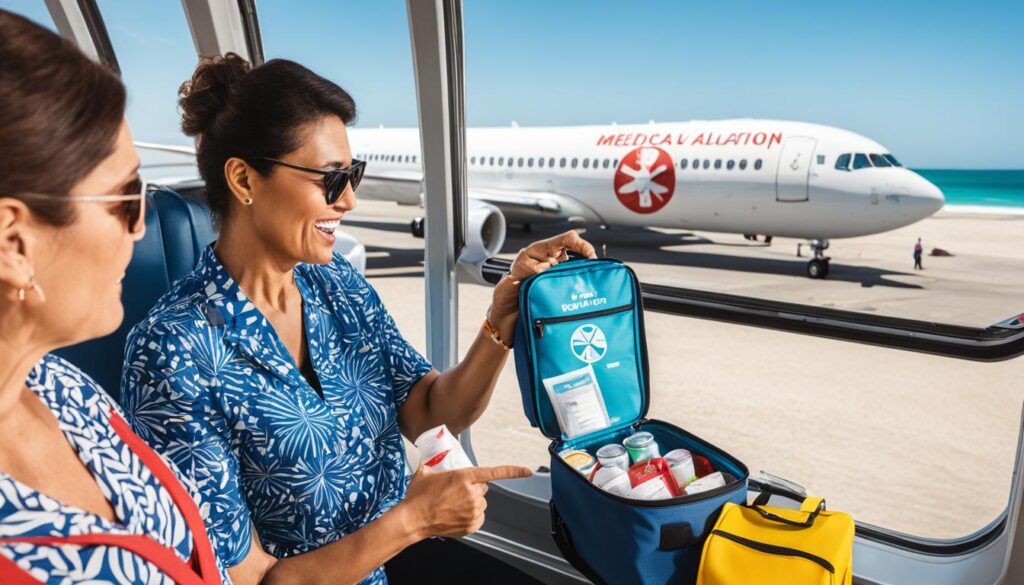If you have food allergies or sensitivities, traveling can be daunting. The fear of having an allergic reaction while away from home can be overwhelming. However, with proper planning and awareness, you can safely enjoy your travels. In this section, we will explore essential tips and advice for traveling with food allergies or sensitivities. Discover how to ensure safe dining experiences, find allergy-friendly travel tips, and locate safe dining options for food allergies that cater to your specific dietary needs.
Understanding Your Food Allergies or Sensitivities
Before embarking on your journey, it’s important to have a clear understanding of your food allergies or sensitivities. You don’t want to be caught off guard in an unfamiliar environment, so research your options and prepare accordingly. Managing food restrictions while traveling can be challenging, but with these helpful tips, you can make your travels safe and enjoyable.
Start by identifying your food allergies or sensitivities. This way, you can avoid certain foods and know what to look out for in menus. If you have multiple allergies, create a list of the foods you must avoid and carry it with you. It might also be helpful to bring translated copies of this list in case you travel to a country where your primary language is not spoken.
Research allergy-free travel resources such as websites, mobile apps, and guides to find appropriate options that cater to your needs. You can also contact local allergy support groups, which have valuable information regarding safe dining options. Additionally, familiarize yourself with the local cuisine and learn about any common ingredients that may cause allergic reactions.
Traveling with food intolerances can be challenging, but with the right preparation, you can manage your specific dietary needs effectively. Remember to pack allergy medication, including antihistamines or an epinephrine auto-injector, in case of an accidental exposure. Consider traveling with a medical alert bracelet or necklace to ensure that medical professionals can be quickly and accurately informed of your allergies in case of an emergency.
Below is a helpful table of allergy-free travel resources for your reference:
| Resource | Description |
|---|---|
| AllergyEats | A website and app that helps you find restaurants with allergy-friendly options in various locations. |
| SelectWisely | A customizable food allergy translation card service that provides translated cards for your specific food allergies or intolerances. |
| Barn2Door | An online marketplace for farm-fresh food delivery with various dietary options such as gluten-free, dairy-free, and vegan. |
| Spokin | An app that provides personalized recommendations for allergy-friendly products, reviewed by a community of allergy sufferers and parents of children with food allergies. |
Remember that managing food restrictions while traveling can be challenging, but by taking the time to understand your specific allergies or sensitivities and utilizing allergy-free travel resources, you can ensure safe and enjoyable travels.
Planning Ahead for Safe Dining
When it comes to traveling with food allergies or sensitivities, planning ahead can make all the difference. To ensure safe dining experiences while on the go, follow these helpful tips:
Research Your Destination
Before your trip, research the dining options available at your destination. Look for restaurants that offer safe dining options for food allergies, and read reviews from other travelers with dietary restrictions. Utilize allergy-friendly travel resources, such as allergy-free travel guides and online communities.
Communicate with Restaurants
Once you arrive, communicate your specific dietary requirements to restaurant staff. Ask for ingredient information and recommendations for safe menu items, or request customized meals to meet your needs. Be sure to clarify any possible cross-contamination hazards with kitchen staff.
Bring Your Own Safe Foods
Packing your own allergy-friendly foods is a smart way to ensure you always have safe dining options available. Bring non-perishable snacks or meals that cater to your specific dietary needs, such as gluten-free or dairy-free options.
| Safe Dining Tips | Allergy-Friendly Travel Tips | Gluten-Free Travel Guide | Dairy-Free Dining on the Go | Nut-Free Travel Tips |
|---|---|---|---|---|
| Research restaurants ahead of time and read reviews from fellow travelers with food allergies. | Utilize allergy-friendly travel resources, such as allergy-free travel guides and online communities. | Look for restaurants that offer gluten-free menu options and communicate your specific needs to restaurant staff. | Ask for dairy-free menu options or request customized meals to meet your dietary requirements. | Pack your own nut-free snacks and communicate any nut allergies to restaurant staff. |
| Call ahead to ask about ingredient information and discuss your specific dietary needs. | Inform airline staff of your food allergies when booking your flight, and bring necessary medications on board. | Use gluten-free travel apps to find safe dining options in new destinations. | Choose vegan-friendly restaurants that offer dairy-free menu options. | Utilize allergy-friendly travel resources, such as nut-free restaurant guides and online communities. |
| Bring non-perishable allergy-friendly snacks or meals when traveling. | Carry emergency medication, such as an EpiPen, with you at all times. | Ask for gluten-free menu options or request customized meals to meet your dietary requirements. | Look for restaurants that offer soy milk or other dairy-free alternatives. | Research restaurants ahead of time and communicate any nut allergies to staff. |
By devoting time to researching safe dining options and communicating effectively with restaurant staff, you can enjoy worry-free dining experiences while traveling with food allergies or sensitivities. Don’t be afraid to bring your own safe foods and utilize helpful allergy-friendly resources, such as travel guides and online communities.
Communicating Your Allergy Needs
When dining out with food allergies or sensitivities, it’s crucial to effectively communicate your dietary needs to restaurant staff. Here are some tips to ensure a safe dining experience:
- Do your research: Before choosing a restaurant, research their menu and allergen policies online. Check out reviews from patrons with similar allergies to gauge their dining experience.
- Inform your server: When you arrive at the restaurant, let your server know about your food allergies or sensitivities. They can guide you towards safe menu items or discuss modifications with the chef.
- Be specific: Don’t be afraid to be specific about your dietary needs. Specify which ingredients you are allergic to and ask about cross-contamination risks. If you’re not confident in the server’s understanding, ask to speak directly with the chef.
- Bring a card: Consider bringing a card or document that outlines your food allergies or sensitivities. This can be helpful if you’re traveling to a foreign country or there’s a language barrier.
By effectively communicating your allergy needs, you can enjoy a safe dining experience while traveling. Remember to always trust your gut and err on the side of caution if something seems off.
Packing Your Own Allergy-Friendly Snacks
Traveling with food allergies or sensitivities can be stressful, especially when it comes to finding safe food options. One way to ensure a worry-free trip is to pack your own allergy-friendly snacks. Not only will this provide you with safe food options, but it can also save you money and time searching for suitable meals.
Here are some tips and ideas for packing allergy-friendly snacks that cater to your specific dietary needs:
- Homemade energy balls: These easy-to-make snacks are packed with nutrients and can be customized to cater to your allergen-free needs. Consider ingredients like oats, dried fruit, and seed butter for a delicious and healthy snack.
- Fruit and nut butter: Cut up your favorite fruits and bring along a small container of nut butter for dipping. This is a simple yet satisfying snack that provides fiber, protein, and healthy fats.
- Rice cakes: Rice cakes are a versatile snack option that can be topped with your preferred ingredients. Consider spreads like hummus, avocado, or dairy-free cream cheese, and add toppings like sliced veggies, seeds, or sliced turkey for a delicious and filling snack.
- Trail mix: Mix together your favorite allergy-friendly nuts, seeds, and dried fruits for a protein-packed snack that is perfect for on-the-go.
- Vegan protein bars: There are plenty of allergy-friendly, vegan-friendly protein bars available on the market. Look for options that cater to your specific dietary needs and contain nutrient-dense ingredients like nuts, seeds, and plant-based protein.
To ensure your snacks stay fresh and safe, pack them in reusable containers with secure lids. Make sure to also bring along any necessary utensils, including plates, napkins, and cutlery.
With these handy tips, packing your own allergy-friendly snacks for travel is easy and stress-free. Not only will you have the peace of mind knowing you have safe food options, but you can also save money and avoid unnecessary meal-time stress.
Navigating Air Travel with Food Allergies
Air travel can be particularly tricky when you have food allergies or sensitivities. Follow these allergy-friendly travel tips to ensure a safe and smooth journey:
- Notify the airline of your allergies: When you book your flight, inform the airline of your specific food allergies or dietary restrictions. Most airlines offer special meals for individuals with specific dietary needs.
- Pack your own food: Packing your own allergy-friendly snacks and meals is always a smart choice. Bring non-perishable items like granola bars, dried fruit, and nuts, as well as fresh items like sandwiches and fruit.
- Read labels carefully: If you do decide to purchase food at the airport, be sure to read the labels carefully. Look for any potential allergens and ask the restaurant or store staff for more information if needed.
- Wipe down your seat and tray table: Bring antibacterial wipes to clean your seat and tray table before and after your flight. This can help reduce contact with potential allergens.
- Carry your medication: Make sure to carry your medication with you at all times and pack extra in case of any delays or unexpected events.
Remember, it’s important to manage your food restrictions while traveling to ensure a safe and enjoyable journey.
Exploring Allergy-Friendly Accommodations
When traveling with food allergies, finding suitable accommodations is crucial to ensure a safe and worry-free trip. Many hotels and resorts offer allergy-friendly accommodations that cater to guests with specific dietary requirements. To help you choose suitable accommodations, here are some allergy-friendly travel tips:
Do Your Research
Before booking a hotel or resort, research its allergy policy and whether it offers allergy-friendly accommodations. Look for hotels that offer hypoallergenic bedding and have staff trained in managing food allergies. Don’t hesitate to call and ask about their food allergy protocols, including if they offer in-room dining or have allergy-aware restaurants on-site.
Choose Suitable Room Amenities
When booking your room, specify any dietary requirements and request a fridge or kitchenette in your room, if available. This allows you to store and prepare your own allergy-friendly meals, giving you greater control over what you eat.
Check for Accommodation Certification
Some hotels and resorts have a certification from allergy organizations such as Gluten-Free Certification Organization or Food Allergy Research and Education. These certifications indicate that the establishment understands and caters to the needs of guests with food allergies, making them excellent choices for allergy-conscious travelers.
Look for On-Site Restaurants with Allergy-Friendly Menus
Some hotels and resorts have on-site restaurants that offer allergy-friendly menus, marked with special symbols to indicate gluten-free, nut-free, or dairy-free options. Be sure to check if the menu items are suitable for your specific dietary needs, and communicate any allergies to your server to ensure a safe dining experience.
Consider Alternative Accommodations
Alternative accommodations such as Airbnbs or vacation rentals can also offer allergy-friendly options. When booking, make sure to communicate your dietary needs to the host and inquire about kitchen facilities or nearby grocery stores that offer allergy-friendly options.
By selecting the right accommodations and using allergy-friendly travel tips, you can have a safe and comfortable journey, no matter where your travels take you.
Dining Out in New Destinations
When traveling to new destinations, exploring local cuisine is part of the adventure. While this can be daunting for travelers with food allergies or sensitivities, there are ways to dine out safely.
Start by researching restaurants that cater to your specific dietary needs. Take advantage of allergy-free travel resources such as guides and apps that can help you find safe dining options. Websites like AllergyEats.com and FindMeGlutenFree.com offer user-generated reviews and ratings for restaurants with allergy-friendly options.
When dining out, communicate your allergy needs to restaurant staff and chefs. Use clear and concise language to explain your dietary requirements. Emphasize the severity of your allergies, and ask questions about the ingredients and preparation of dishes. It’s also a good idea to inform servers about any cross-contamination concerns.
Be creative with your meal choices and don’t be afraid to ask for modifications to menu items to make them safe for you to eat. For example, if you have a nut allergy, ask if the kitchen can use a different type of oil for cooking your dish.
Lastly, consider packing a portable allergy kit with you on your travels. Include essentials like antihistamines, an Epipen, and any other medication you need if an allergic reaction occurs.
By doing your research, communicating your needs, and being proactive about your dining choices, you can safely enjoy new destinations while managing your food allergies or sensitivities.
Conclusion
Traveling with food allergies or sensitivities can be a challenge, but with the right preparation and knowledge, you can have a safe and enjoyable journey. Remember to plan ahead for safe dining options, communicate your allergy needs effectively, and pack your own allergy-friendly snacks to ensure access to safe food options at all times.
Be sure to understand your specific dietary needs and research allergy-free travel resources before embarking on your journey. Consider exploring allergy-friendly accommodations and strategies for dining out in new destinations.
By following these allergy-friendly travel tips and utilizing available resources, you can minimize risk and enjoy a stress-free journey. Bon voyage!

















































